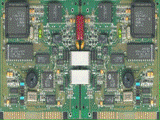Electrical & Computer Engineering, Department of
Date of this Version
2000
Abstract
Coherent random noise radar has been developed at the University of Nebraska for the detection and identification of shallow subsurface objects such as land mines. Other application ranges from remote sensing, synthetic aperture radar and high-resolution interferometer, to covert target tracking. in this paper, we describe the experimental investigation of a novel applicntion of superfluorescent fiber or erbium doped fiber amplifier (EDFA) light sources(SFS) for random noise radar. The ultra-wide band noise coupled with the use of optical fiber delay lines makes SFS ideally suited for random noise radar applications. Optical fiber- makes long and multiple-step delay lines of a few kilometers feasible. lts advantage includes being extremely low-loss, compact and lightweighted, and available at a much lower cost, while avoiding the dispersion and non-linearity associated with RF delay lines. We report the analysis and experimental results to characterize the resolution characteristics of the system.


Comments
Published in MILCOM 2000. 21st Century Military Communications Conference Proceedings
Vol. 2, pp. 907-911; doi: 10.1109/MILCOM.2000.904062 Copyright 2000 IEEE. Used by permission.